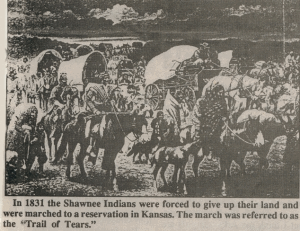
Window to the Past
Indians - Part 1
By BOB HOLDGREVE
The Indians who lived in the area from the Atlantic Ocean in the east to the Mississippi river in the West and from southern Canada to Kentucky were known as the Woodland Indians. Those from the rest of the country were known as the Plains Indians.
Tribes that were located in this region were Shawnees, Ottawas, Miamis, and Wyandots.
The Indian trails often followed the high ground and later became known as the "ridge roads." In some instances, these trails determined the location of white settlements, forts, and military roads, some of them later becoming public highways. In our area, the Lincoln Highway and SR 12 followed the ridge, called sugar ridge by early settlers. This was an Indian trail which ran roughly from Fort Wayne to Findlay. Around 10,000 years ago, this ridge was the south edge of Lake Erie. The Defiance Trail was another Indian Trail and later a military road and then a public highway.
Shawnee township was originally an Indian reservation of 25 square miles. There was an Indian village located there on the old Ezekiel Hover farm. It was here that Blue Jacket and other notable chiefs met with Chief Black Hoof.
Next to the Shawnee Township reservation was the 100 square mile Shawnee reservation at Wapakoneta. (More about that one later).
The Hon. T.E. Cunningham stated that Shawneetown was an Indian village, situated on Hog Creek. (Ottawa River). Quilna was the great businessman of the tribe. Soon after the McClure settlement was commenced, they heard from the Indians that the government had erected a mill (to grind corn into corn meal) at Waupaukonnetta. The settlers had no road to the mill, but Quilna assisted them in opening one. He surveyed the line of their road, without compass, designating it by his own knowledge of the different points, and the Indian method of reaching them. He was called the pathfinder of the Shawnees.
There are many children of the early settlers to whom the name of Quilna is a household name. To his business qualities were added great kindness, and a thorough regard for the white people. No sacrifice of his personal ease was too much if, by any effort, he could benefit his new neighbors. Cunningham stated that this community had been ungrateful. Some enduring memorial of Quilna should have long ago been made. How much better and more appropriate would have been his name to the new township, (Ottawa, in which Lima is situated), in our county, over which his tired feet had so often trodden, in the bestowal of kindness upon the white strangers, who had come to displace his tribe where his forefathers slept. Why cannot Ottawa township be changed to Quilna yet?
Quilna was always recognized as a crafty Indian. One day a settler named Breese, bargained a hog to Quilna in exchange for a deer. It was to be a doe, young and fat, and when Quilna finally killed it, he hung it up in the woods. He left it there until purification began, and when the settler objected to the carcass, Quilna pretended to not understand. He argued the question saying, "He fat," Breese admitted it. Quilna said: "He doe," and the settler agreed with him. "He young," was Quilna's next defense, when Breese cleared up matters by saying, "Yes, I'll admit all that you say, but do not want the deer, it does not smell good; it is spoiled," and when the situation finally dawned upon Quilna, he replies: "Ah, me know, he too dead," and there was no bargain between them. While venison was a wilderness luxury, the settler had sanitary standards the Indians knew nothing about, and Quilna lost out in the deal with Breese.
From the Delphos Herald - Jan. 3, 1878: Quilna, once famous chief of the Shawnee tribe of Indians, with headquarters in Shawnee township, Allen County, is still alive. Capt. Patrick informs us that the old chief is now with the Shawnees in the Indian territory, and that he is about 90 years old. The captain, who is at present on a visit among relatives in this county, proposes to take back with him, a cane made from the old Shawnee council house, and present it to Quilna.
It is said that of all the Shawnees in Allen County, Pht, (Pe-Ditch-Ta) was the most widely known and honored, that he was a natural leader among the tribes in Western Ohio. Pht was a leader in tribal difficulties and the world has always welcomed men with initiative. It was through Pht's influence that the Shawnee Council House was built. After a long illness, he was buried in the garden near his cabin, the grave being dug by his wife and daughter. The settlers looked upon the Shawnee Chief with admiration - they regarded him as a man who would have distinguished himself in community and in any nationality.
In 1831, the Shawnee Indians were forced to give up all their land and were marched to a reservation in Kansas. This forced march was called the "Trail of Tears." Many died on the way.
The game of stickball was originated by the Woodland Indians and was called Lacrosse by the French settlers.

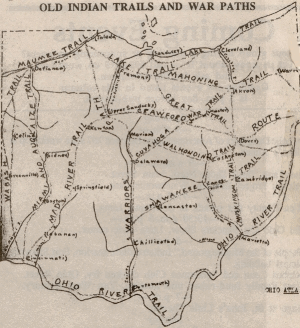
From the Lima News - July 11, 1999: A five-ton granite rock is what the local Native Americans have chosen to honor the Shawnee Indian Chief Pht. After months of waiting and anticipating, the stone is sitting at Shawnee Cemetery, just across the street from the chief's 168-year-old grave.
"The rock is near the chief's grave, without being on private property," says Helen Spyker, a member of the Native American interest group, People of the Middleground. That group selected the stone, which they believe has special significance.
"We were drawn to that rock because of the symbols on it. It's a powerful rock, fitting for a chief," said member Brenda Hawk.
The granite rock has a rose quartz serpentine symbol across the top, and a turtle symbol facing the northeast. "Grandmother earth is the turtle, and that's a sacred symbol," explained Hawk. And for some, the rock contains even more symbols. "Some have seen faces in the rock; others have seen a medicine wheel," recalls Hawk.
Editor's note: The next article or two will include information on the Indian reservations at Charloe, Paulding County, Shawnee at Wapakoneta, and Indian village at Ottawa.
For much more detailed information, check the Delphos Public Library's selection of books about Indians and county history books.
The information for this article was obtained from several Allen County and Van Wert County history and Atlas books at the library.
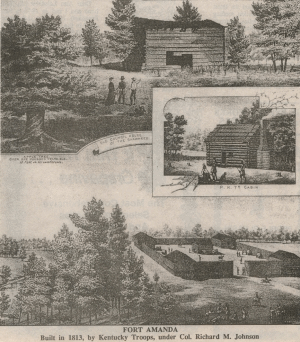
Compiled by Robert Holdgreve
Delphos Historical Society
August 21, 1999 Delphos Herald Newspaper
Indians - Part 2
By BOB HOLDGREVE
In 1825, Samual McCluer built a cabin on the west bank of Hog Creek in Bath Township, Allen Co. In February 1826, his family moved into the new cabin. The Indians were very numerous and friendly, and always coming up laughing for a handshake, saying, "young friend."
The Indians camped every spring and fall on McCluer's farm during the hunting season. McCluer, it was reported, spent many a day in company with some of the young redskins, shooting with the bow and arrow, with which there were two Indian boys that could knock out a bird's eye at from 50 to 75 yards. I saw them do it many times. I also have seen them lodge an arrow in the top of a large tree, and then shoot it out with another. The father of these two boys went by the name of "Jim Jack". The Indians often hunted for the lost stock of the settlers, and were very friendly, helping at cabin raisings, and other work.
Francis Stevenson came to Allen County in the fall of 1829. He and some of his hands built a small log cabin on Section 17. They then took a wagon load of corn and meat, and stored them in the loft for the use of his family when they would come in the spring. The door was held shut only by a wooden latch. In March, Stevenson and family arrived at the cabin and were greatly surprised to find that the corn and hams were undisturbed by the Indians, who knew that they were stored there.
In a few hours, an old Indian and his band made the family a visit. The Chief desired to buy corn for his ponies and meat for the Indians as they were short of the supplies. Mr. Stevenson said that he could supply both. The chief exchanged venison for some corn and hams. Mr. Stevenson says that even though the Indians knew the supplies were there, and they were short of the supplies, not an ear of corn had disappeared. They were nature's children, and possessed the most unflinching sense of true honesty. In these times of high moral ideas, it would be very doubtful whether such a store would remain undisturbed by men of our own color.
Blackhoof (Indian name, Quaskey), Chief of the Shawnees at Wapakoneta, established his council house there, and the chief village of the Shawnees became the acknowledged center of the tribe. Old Chief Blackhoof had his last camp on the summit of one of the hills at what is now (1923) the site of the village of St. Johns, Ohio, old Blackhoof Town, and there he spent his last days and was buried there. Blackhoof was said to have died at the age of 110.
Blue Jacket, who led the Indians against Wayne at the battle of Fallen Timbers, once lived at Wapakoneta.
Judge Burnet of Cincinnati, relates that in one of his trips from Cincinnati to Detroit on horseback, he stopped at Wapakoneta and called upon the old Indian Chief, Bohengeehalies, who received him kindly, and called in some of the young men, requesting them to get up a game of "football". A purse of trinkets was made up and all the village gathered on the lawn. The men played on one side and the women on the other. The rules did not allow the men to touch the ball with their hands on penalty of forfeiting the purse, while the women had the privilege of picking it up, running with it and throwing it as far as they could. When a woman had the ball, the men were allowed to catch and shake her and even throw her to the ground, if necessary to extricate the ball from her hand, but they were not allowed to touch or move it, except with their feet.
At the opposite extremes of the lawn, stakes were placed about six feet apart. The contending parties placed themselves in front of the stakes, the men on one side and the women on the other. The party that succeeded in driving the ball through the stakes at the goal of their opponents, were the victors and received the purse. All being ready, the old Chief went to the center of the lawn and threw up the ball, making an exclamation in the Shawnee language, when he immediately retired and the game began.
The parties were evenly matched, being about a hundred on a side. The game lasted more than an hour with great animating but was finally decided in favor of the women, by the power of a woman who secured the ball and held to it, in spite of the men who seized her and attempted to shake it from her uplifted hand. She dragged them along until sufficiently near to throw it between the stakes. When the contending parties retired from the field, it was pleasant to see the feeling of exultation on the faces of the victors.
An Indian was considered poor if he did not possess a pony, gun, tomahawk, dog, knife and blanket.
A young Indian strayed away from his camp and got lost. Inquiring the way back, he was asked, "Indian lost?" "No," said he, "Indian not lost, Indian here; wigwam lost."
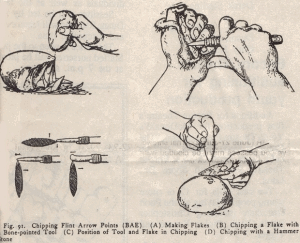
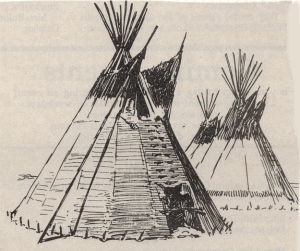
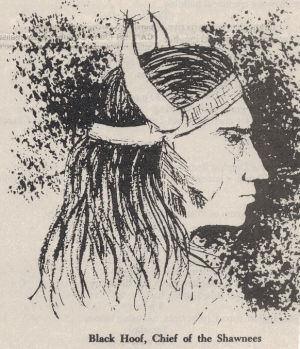
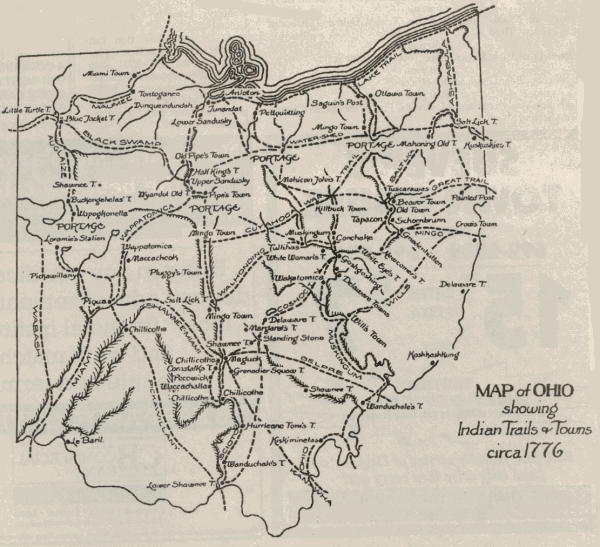
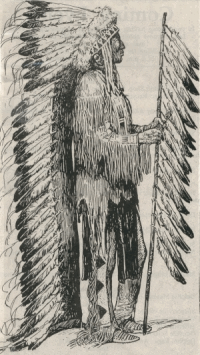

Compiled by Robert Holdgreve
Delphos Historical Society
September 18, 1999 Delphos Herald Newspaper
More about area Indians - Part 3
By BOB HOLDGREVE
Paulding County
At one time, the very ill daughter of Chief Oquanoxa was brought to Dr. John Evans, father of Dr. S.A. Evans of Delphos, for treatment. When her health was restored, the chief presented to the doctor, one of his finest horses.
Putnam County
The Indian village Tauwas, was called Tawa by the early settlers. It is now
1915, a part of the town of Ottawa. The village is known to have existed as far
back as 1750, and was visited by French missionaries and few traders from that
period until 1832. The village was located on the Indian trace from Wapakoneta
to the foot of the rapids on the Maumee river.
The last Indian who made his home in Tawa village was buried here in 1835. One was buried near Fort Jennings as late as 1838-39.
Prior to 1812, Tawa village consisted of some twenty five "shacks" or cabins, the most being constructed of a few poles set in the ground and covered with bark.
When Michael Row came to Ottawa, a portion of the Ottawa Indians were still here, and their Chief Pedanquit, kept a small stock of goods which he sold to his tribe and to the early white settlers. The council house was then standing on the site known as "Indian green" and was from time to time occupied by the early settlers until they could erect cabins on their lands.
In 1833, the government bought the reservations from the Indians. The Indians remained here until about 1835-36 when nearly all of them were deported to their new land in Missouri, now a part of Kansas. A few stragglers remained here in the vicinity of Fort Jennings as late as 1839, when the last red man disappeared from Putnam County.
The Ottawa Indians were loath to leave their reservation here. It was an ideal place for making maple sugar, fish were plenty, game abounded. During their occupancy here, these recognized Petoniquet as their new chief, yet, they spoke of him as their "half-chief." On being asked why they called him this, their answer was that he had a twin brother who was a chief, and as the twin brother had been killed, Petoniquet could only be a "half chief 'and not a full chief. All mention of Petoniquet by the white men who came here from 1833 to 1836 was favorable to him, and all the pioneers agreed upon the fact that he was sober in habits, honest in his dealings and kind in disposition.
Pontiac, one of the greatest Indian leaders, was an Ottawa Indian and said to have been born near Defiance, Ohio.
The few white inhabitants in north-west Ohio around 1800, were Canadian French, Indian traders or renegade Tories.
Van Wert County
Between 1835 and 1840, Oliver Stacy settled on the Ridge Road, four and a
half miles west of Delphos. An Indian grave was found near his east line where
the Ridge Road entered his land. The burial place must have been that of a great
chief by the relics found. Another burial place is known on the William
Martin farm, two miles west of the Stacy farm, which contained two Indians.
There was a time when the spot was surrounded by a crude pole fence, but
possibly the last remaining vestige of the evidence is gone.
J.B. Pollock, while digging in the earth near his celebrated spring west of Van Wert, found a hatchet of a peculiar and ancient pattern. It was turned over for inspection to Robert Le Hew, who it is claimed is an expert on hatchetology. Le Hew, after careful inspection, claims that it was wielded by the chief of a tribe of Indians that formerly existed in that locality.
From the Delphos Herald, 1895
In 1818, at St. Marys, a treaty was signed in which all of the lands north
of the Greenville Treaty line in Ohio to the Great Lakes was ceded to the United
States except certain small reservations at various points. Two of these were in
Van Wert County - the John B. Richardville Reserve in Willshire Township, and
the La Badie Reserve south of the St. Marys River, part in Willshire
Township, and part in Blackcreek Township, Mercer County. The lands ceded to the St. Marys Treaty were known as the "Congress Lands."
Sources are from various county history books.
This iron tomahawk pipe was found in Paulding County. It is a good example the type traded to the Indians, which could be used in battle or for smoking.
Compiled by Robert Holdgreve
Delphos Historical Society
October 16, 1999 Delphos Herald Newspaper